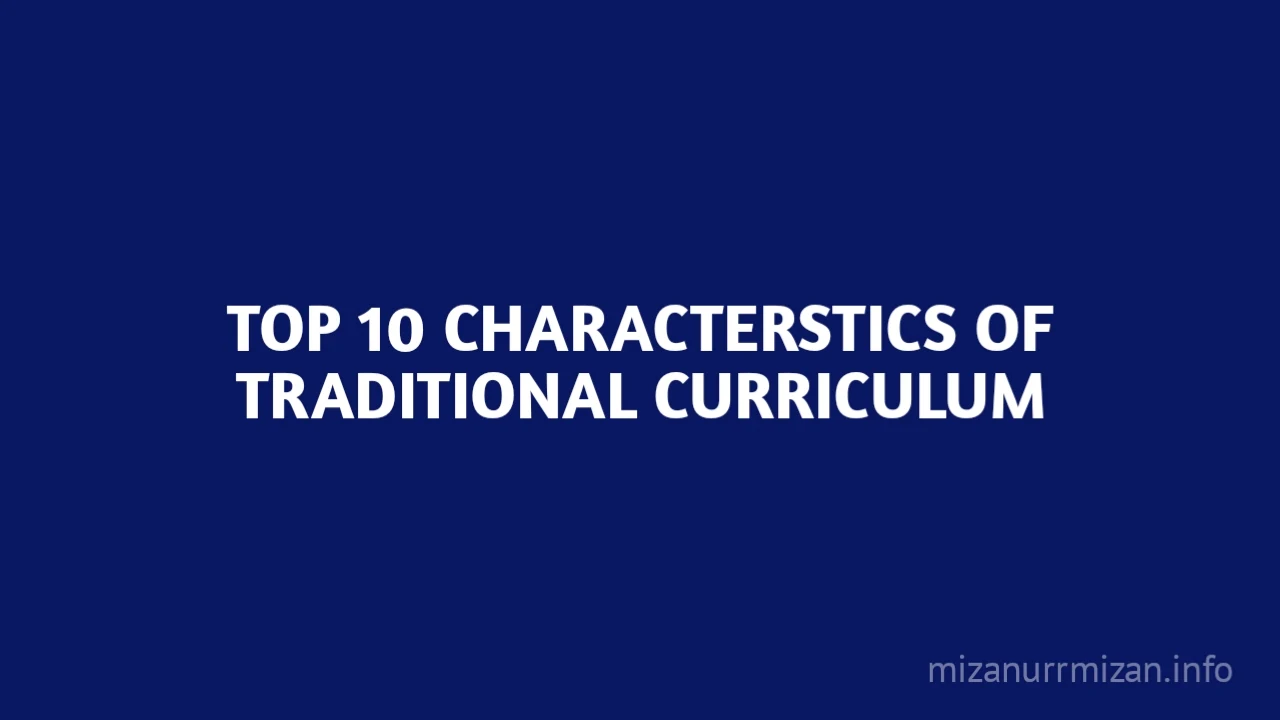Education, as a dynamic and evolving field, has witnessed the rise and fall of various pedagogical approaches. One such approach, deeply rooted in history and philosophy, is the traditional curriculum. With its enduring principles and practices, the traditional curriculum has shaped the foundations of education for centuries. This article delves into the top 10 defining characteristics of the traditional curriculum, highlighting its historical significance, influence, and relevance in contemporary educational discourse.
Table of contents
Definition: What is Traditional Curriculum?
Traditional Curriculum refers to an educational framework that emphasizes core academic subjects, teacher-centered instruction, and structured learning methods. Rooted in historical educational practices, this approach prioritizes foundational disciplines such as mathematics, language arts, science, and history. It places the teacher as the primary source of knowledge, employing methods like memorization and rote learning to build a solid factual foundation. The curriculum follows a sequential progression, ensuring concepts are introduced systematically. While criticized for limited flexibility, it aims to cultivate academic excellence and instill values through standardized assessments and moral education.
Top 10 Characteristics of Traditional Curriculum
1. Emphasis on Foundational Subjects
Central to the traditional curriculum is the emphasis on foundational subjects. Mathematics, language arts, science, and history are considered essential for nurturing well-rounded individuals with a broad understanding of human knowledge. The traditional curriculum seeks to provide students with a comprehensive education that equips them with essential skills and knowledge applicable to various aspects of life.
2. Teacher-Centered Instruction
The traditional curriculum embraces a teacher-centered instructional model. Teachers assume the role of authoritative figures who possess knowledge to impart to their students. This approach cultivates a sense of respect for authority and offers students the opportunity to learn from experts in their respective fields. The classroom dynamic revolves around lectures, demonstrations, and direct instruction, ensuring that students receive structured content.
3. Memorization and Rote Learning
While often criticized for focusing on rote memorization, the traditional curriculum places importance on memorization as a foundational skill. Students are encouraged to commit facts, formulas, and historical dates to memory. This practice, though not exclusive to the traditional curriculum, aids in building a strong factual foundation that supports further learning and critical thinking.
4. Sequential and Linear Progression
In the traditional curriculum, learning follows a logical and sequential progression. Concepts are introduced in a structured manner, allowing students to build upon their understanding step by step. This approach is particularly suited to subjects like mathematics and language, where mastery of earlier concepts is crucial for grasping more complex ideas.
5. Discipline and Order
Discipline and order are intrinsic components of the traditional curriculum. Students adhere to set schedules, follow established rules, and adhere to standardized assessments. This structured environment fosters good behavior, time management skills, and a sense of responsibility among students, qualities that extend beyond the classroom.
6. Standardized Testing
Assessment in the traditional curriculum often revolves around standardized testing. These tests evaluate students’ knowledge based on predetermined criteria, providing educators and policymakers with quantifiable data on student performance. While some argue that standardized tests emphasize memorization over critical thinking, they play a role in maintaining consistency and uniformity in evaluating student achievement.
7. Moral and Cultural Education
The traditional curriculum often integrates elements of moral and cultural education. Classical literature, historical events, and philosophical concepts are used to instill values, ethics, and cultural awareness in students. By exploring the thoughts and experiences of those who came before, students gain a broader perspective of the human experience and develop a sense of identity and empathy.
8. Authority of Textbooks
Textbooks play a pivotal role in the traditional curriculum. They serve as primary resources, containing structured content and prescribed knowledge. Teachers closely follow textbooks, ensuring that the curriculum is delivered uniformly across classrooms. While some criticize this reliance on textbooks for inhibiting creativity, they offer a consistent foundation for learning.
9. Limited Flexibility
One characteristic that distinguishes the traditional curriculum is its limited flexibility. The curriculum’s prescribed subjects and methodologies leave little room for tailoring education to individual learning styles, interests, or cultural backgrounds. While this rigidity can be advantageous in ensuring a comprehensive education, it may fall short in addressing the diverse needs of all students.
10. Focus on Academic Excellence
Ultimately, the traditional curriculum places a strong emphasis on academic excellence. The goal is to equip students with a deep understanding of core subjects, preparing them for higher education and professional success. This emphasis on academic achievement seeks to ensure that graduates are well-prepared to contribute to society and succeed in their chosen careers.
Conclusion
In a rapidly evolving educational landscape, the traditional curriculum continues to exert its influence. While critics question its emphasis on rote learning and limited flexibility, its enduring focus on foundational subjects, moral education, and academic excellence still hold relevance. Balancing tradition with innovation remains a challenge for educators seeking to shape well-rounded individuals for the modern world.
Summary
The traditional curriculum is an education approach that highlights core subjects, teacher-centered instruction, and structured learning. It emphasizes foundational disciplines like math, science, history, and language arts. Teachers play a central role, utilizing methods such as memorization and rote learning. Learning follows a sequential path, building concepts progressively. While criticized for inflexibility, it aims to foster academic excellence and values through standardized assessments and moral education.
Bibliography
Egan, K. (2002). Getting it wrong from the beginning: Our progressivist inheritance from Herbert Spencer, John Dewey, and Jean Piaget. Yale University Press.
Hirsch, E. D. (1987). Cultural literacy: What every American needs to know. Vintage.
Kliebard, H. M. (2004). The struggle for the American curriculum, 1893-1958. Routledge.
Ravitch, D. (2000). Left back: A century of failed school reforms. Simon & Schuster.
Sowell, T. (1993). Inside American education: The decline, the deception, the dogmas. Simon & Schuster.
Tyack, D., & Cuban, L. (1995). Tinkering toward Utopia: A century of public school reform. Harvard University Press.


Post a Comment
Write you think.